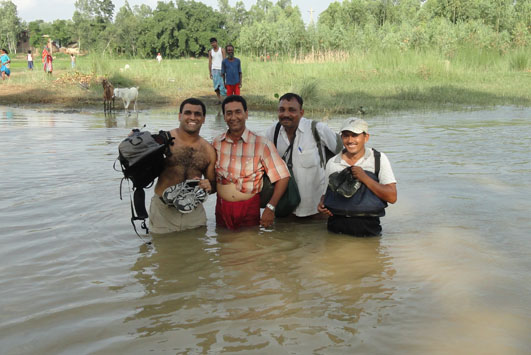My Research in Nepal
Sutyajeet Soneja, PhD '14
My first visit to Nepal was during monsoon season. I was there to collect preliminary data with the cookstove research team. Because of heavy rains and flooding, many sites are inaccessible by motorbike so we had to walk…or in this case, wade across a river! So wade we did!
In the Hindu-Kush mountain region, glaciers, which act as a water source for over a billion people, are retreating at a rapid rate. In addition, weather patterns are becoming less predictable and more intense which adds to the potential economic and health impact. Climate change agents, such as black carbon, are believed to be key contributors to these changes. My overall research premise was to understand how much black carbon is exiting village households during the burning of biomass fuels during cooking events to try and better understand the role that cooking plays in the production of black carbon in this region of the world. My research was based in Sarlahi District, Nepal where a field research site was setup 25 years ago by the Johns Hopkins Department of International Health and where multiple projects are currently underway. I lived there with a few other PhD students from that department for over a year. Sarlahi is a very rural, remote area and Nepal has many problems facing it, including rolling power outages (with electricity limited to only a few hours per day depending on the season) and abject poverty. I made multiple visits to Nepal during different phases of my research.

My first visit was in the summer of 2011 for about 6 weeks. This was a preliminary site visit that allowed for me to meet the staff and embed myself with the cookstove research team. This team was collecting indoor environmental data for the parent cookstove trial, which is looking at health effects due to exposures from the burning of biomass fuels during cooking. I got a chance to collect some preliminary data, see how my own equipment would perform in the harsh environment (heat >100° Fahrenheit, middle of monsoon season, dust, and limited electricity), think about the logistics of my own study, and most importantly develop relationships with the staff that I would be working with closely.
"I came to absolutely love Nepal and had an amazing experience...
-Sut Soneja, PhD '14
My second visit was in the spring of 2012. During this phase of the project I was interested in finding out how much particulate matter and black carbon actually escapes from village homes during cooking events. Much of it will deposit on walls or other surfaces within the home, so knowing how much black carbon gets outside will ultimately help to determine how it is contributing to climate change. During this phase of the project, we built a mock home in Sarlahi that mimicked a village hut and performed extensive testing to figure out how much black carbon exits the home during cooking events. We then performed a similar series of tests in 50 actual homes to see what the variability would be in our estimates.

My third visit was from the fall of 2012 to spring of 2013. During this phase we wanted to characterize outdoor particulate matter and black carbon during cooking and noncooking events. We spent several months mapping the villages and taking outdoor air samples at multiple sites to form the crux of what will be a spatial model that characterizes these pollutants across a large area during these two time periods. Furthermore, as part of ongoing work, we will be able to use data from the parent cookstove trial upon its completion to better inform our model and develop our understanding with regards to black carbon production from cooking to outdoor air.
My fourth visit was in the early part of 2014 where I collected additional data looking at how improved cookstoves that utilize a chimney change the amount of black carbon that exits to the outdoor environment.
I came to absolutely love Nepal and had an amazing experience while I was there. In addition to making lifelong friends and learning all about another culture, I also got to do some amazing hiking in the Everest and Annapurna regions! I hope I have the opportunity to return soon!
-Sut Soneja, PhD '14
Sut's field-based research in Nepal was funded in part by a Environmental, Energy, Sustainability, and Health Institute (E2SHI) Seed Grant.
